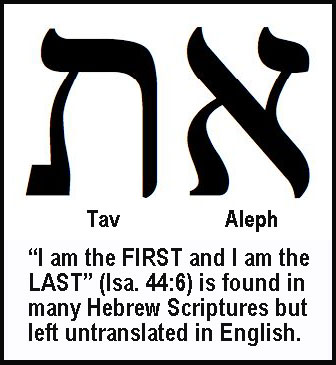
There are 419,687 words in the Hebrew Bible (TNK: 39 books -- Luke 24:44). Of this total, 7034 words are aleph-tav. They're not translated into English. Strong's Concordance, #853 says, "unrepresented in English". That's about 2% left untranslated. People say "eth" means "it" or "namely". But could there be another, much better meaning?
Our Lord is described in the Bible as "the First and the Last" in Isaiah 41:44, 44:6, 48:12, Revelation 1:11, and 22:3. He is also described as "the Alpha and the Omega" in Revelation 1:8, 1:17-18, 2:8, 21:6, and 22:3. But overlooked is the fact that the same equivalent construction is found in the Hebrew Old Testament. The first and the last letters of the Hebrew alphabet are Aleph and Tav. When used with a connector bar, or maqqeph, the two-letter prefix ALEPH/TAV is used as a grammatical element to indicate a direct object of the verb.
But that is only one of four uses of that construction. There are instances where ALEPH/TAV is used as a pronoun to indicate the second person masculine singular.
An example is Zechariah 12:10 which says, "And I will pour upon the house of David, and upon the inhabitants of Jerusalem, the spirit of grace and of supplications: and they shall look upon me (ALEPH/TAV) whom they have pierced, and they shall mourn for him, as one mourneth for his only son, and shall be in bitterness for him, as one that is in bitterness for his firstborn." These two letters between the "me" and the "whom" remain untranslated.
In Genesis 1:1 we read, "In the beginning God created (ALEPH-TAV) the heaven and the earth." A maqqeph is not required grammatically. The verse is saying that Jesus Christ created everything. His signature is the ALEPH and TAV.
Genesis 46:30 says, "And Israel said unto Joseph, Now let me die, since I have seen thy (ALEPH-TAV) face, because thou art yet alive."
Exodus 3:3 says, "And Moses said, I will now turn aside and see this great (ALEPH-TAV) sight, why the bush is not burnt."
Exodus 12:8 says, "And they shall eat the (ALEPH-TAV) flesh in that night, roast with fire and unleavened bread; and with bitter herbs they shall eat it."
Exodus 12:13 says, "And the blood shall be to you for a (ALEPH-TAV) token
upon the houses where ye are; and when I see the (ALEPH-TAV) blood, I will pass over you".
Exodus 12:17 says, "And ye shall observe the feast of (ALEPH-TAV) unleavened bread ... forever"
Exodus 16:31 says, "Israel called the name thereof (ALEPH-TAV) Manna"
(see John 6:31-40).
Deuteronomy 6:5 "And thou shalt love (ALEPH/TAV) the LORD (YHWH) thy God with all thy heart, and with all thy soul, and with all thy might."
Joshua 2:18 mentions a (ALEPH-TAV) "scarlet thread"
which reminds us of Acts 16:31: "Believe on the Lord Jesus Christ, and thou shalt be saved, and thy house."
Jesus is mentioned in the book of Esther 110 times as ALEPH-TAV.
Isaiah 53:6 says, "All we like sheep have gone astray; we have turned every one to his own way, and the Lord hath laid on him (ALEPH-TAV) the iniquity of us all" (53:6).
Malachi 1:6 says, "A son honoreth his father, and a servant his master; if, then, I be a father, where is mine honor? And if I be a master, where is my fear? saith the Lord of hosts unto you, O priests, that despise (ALEPH-TAV) my name."
Malachi 2:4 mentions the (ALEPH-TAV) "commandment"
and Malachi 2:9 says, "Therefore have I made you contemptible and base before all the people, because you have not kept (ALEPH-TAV) my ways, but have shown partiality in the law". Malachi 3:10 promises: "Bring you (ALEPH-TAV) all the tithes into the storehouse, that there may be food in mine house, and prove me now herewith, saith the Lord of Hosts, if I will not open you (ALEPH-TAV) the windows of heaven, and pour out for you a blessing, that there shall not be room enough to receive it."
The word ALEPH/TAV is used as a preposition very frequently (over 7,000 times) in the Hebrew bible. Because the preposition ALEPH/TAV has no equivalent in the English language, it is not translated. But our Lord's signature is all through the Bible.
See Messianic Aleph Tav Scriptures by William Sanford